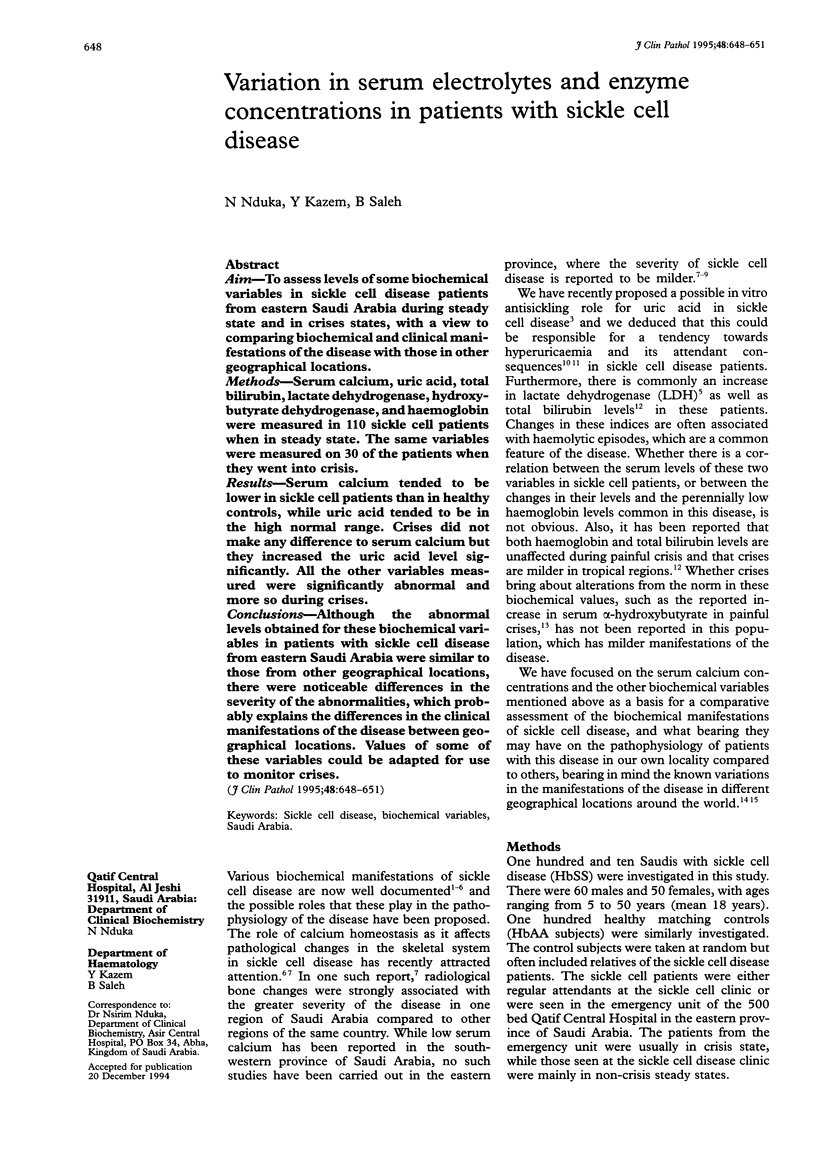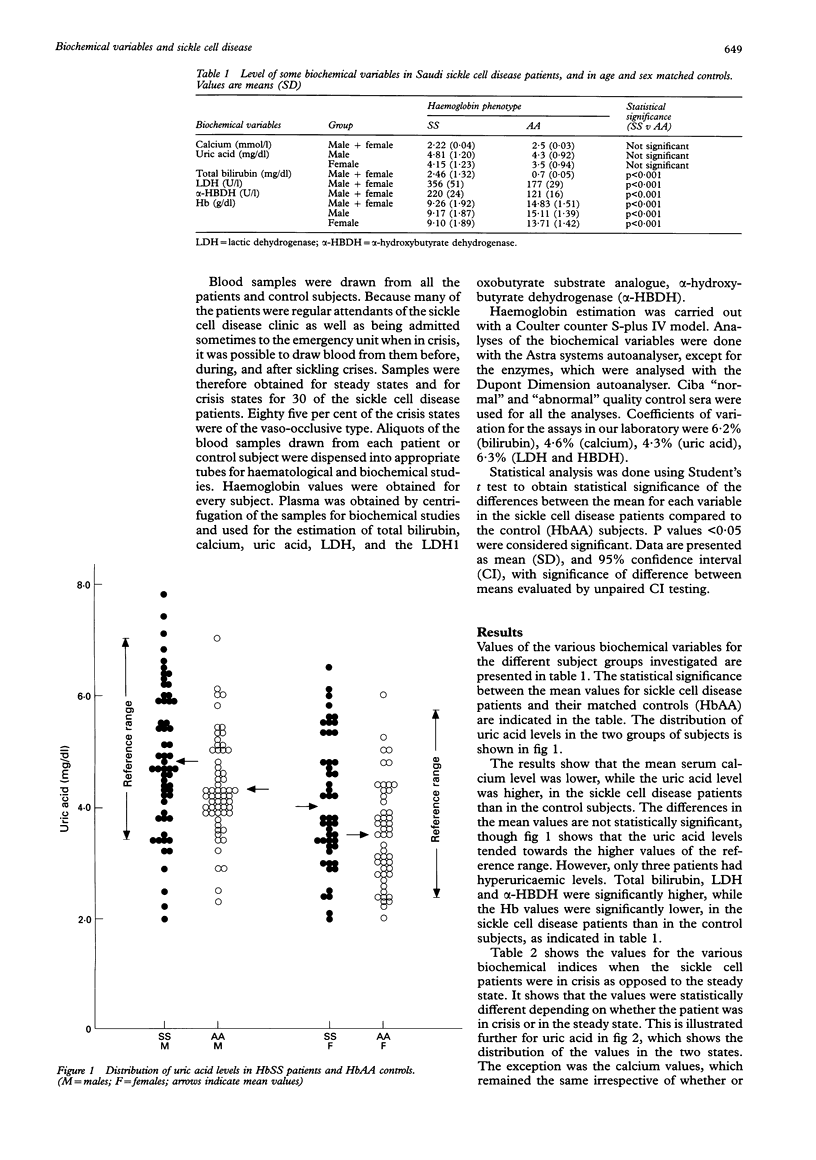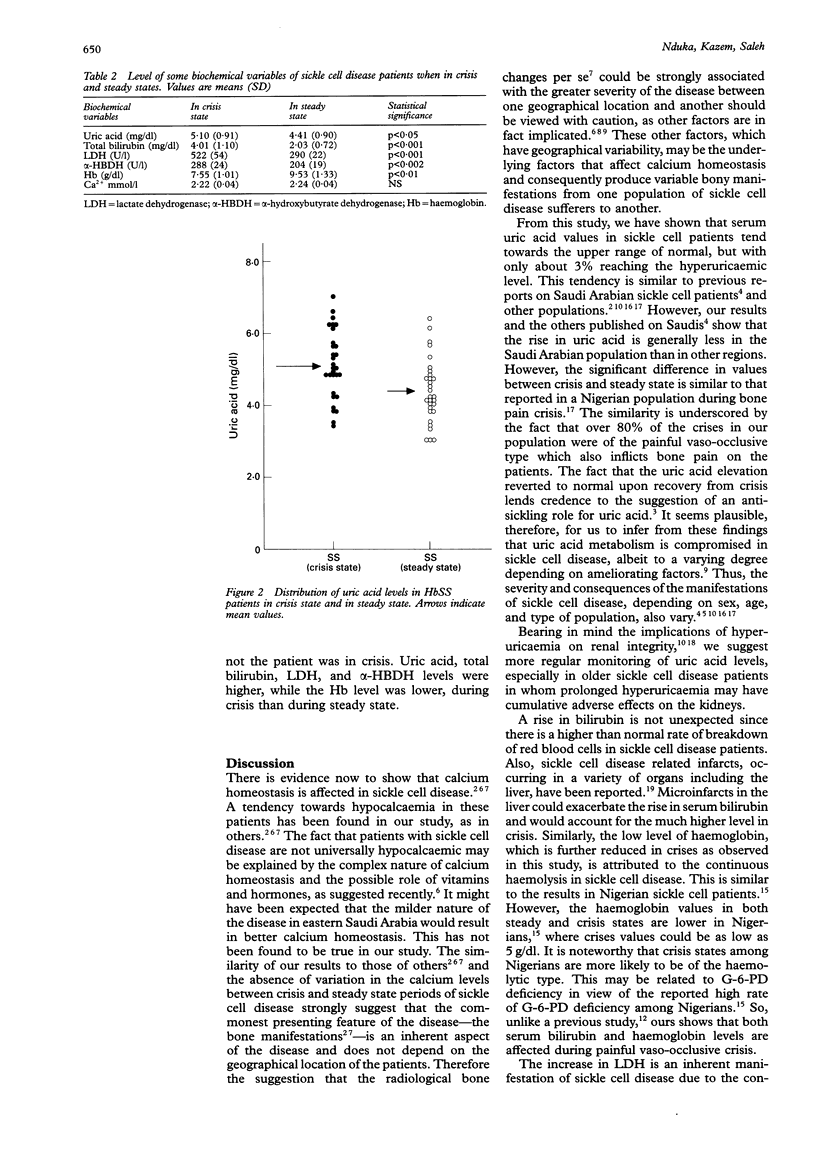Abstract
AIM--To assess levels of some biochemical variables in sickle cell disease patients from eastern Saudi Arabia during steady state and in crises states, with a view to comparing biochemical and clinical manifestations of the disease with those in other geographical locations. METHODS--Serum calcium, uric acid, total bilirubin, lactate dehydrogenase, hydroxybutyrate dehydrogenase, and haemoglobin were measured in 110 sickle cell patients when in steady state. The same variables were measured on 30 of the patients when they went into crisis. RESULTS--Serum calcium tended to be lower in sickle cell patients than in healthy controls, while uric acid tended to be in the high normal range. Crises did not make any difference to serum calcium but they increased the uric acid level significantly. All the other variables measured were significantly abnormal and more so during crises. CONCLUSIONS--Although the abnormal levels obtained for these biochemical variables in patients with sickle cell disease from eastern Saudi Arabia were similar to those from other geographical locations, there were noticeable differences in the severity of the abnormalities, which probably explains the differences in the clinical manifestations of the disease between geographical locations. Values of some of these variables could be adapted for use to monitor crises.
Full text
PDF



Selected References
These references are in PubMed. This may not be the complete list of references from this article.
- Acquaye J. K., Omer A., Ganeshaguru K., Sejeny S. A., Hoffbrand A. V. Non-benign sickle cell anaemia in western Saudi Arabia. Br J Haematol. 1985 May;60(1):99–108. doi: 10.1111/j.1365-2141.1985.tb07390.x. [DOI] [PubMed] [Google Scholar]
- Adeyokunnu A. A., Osanyintuyi V. O. Serum uric acid status of Nigerian children with sickle cell disease. East Afr Med J. 1984 Feb;61(2):145–149. [PubMed] [Google Scholar]
- Ekeke G. I., Nduka N. The antisickling role of uric acid in sickle cell disease. Trop Geogr Med. 1987 Apr;39(2):152–156. [PubMed] [Google Scholar]
- Gold M. S., Williams J. C., Spivack M., Grann V. Sickle cell anemia and hyperuricemia. JAMA. 1968 Nov 11;206(7):1572–1573. [PubMed] [Google Scholar]
- Hunt B. J., Korsah P., Eaton S., Brozovic M. Creatine kinase activity in sickle cell disease. J Clin Pathol. 1989 Jul;42(7):712–715. doi: 10.1136/jcp.42.7.712. [DOI] [PMC free article] [PubMed] [Google Scholar]
- Mohammed S., Addae S., Suleiman S., Adzaku F., Annobil S., Kaddoumi O., Richards J. Serum calcium, parathyroid hormone, and vitamin D status in children and young adults with sickle cell disease. Ann Clin Biochem. 1993 Jan;30(Pt 1):45–51. doi: 10.1177/000456329303000108. [DOI] [PubMed] [Google Scholar]
- Morgan A. G., De Ceulaer K., Serjeant G. R. Glomerular function and hyperuricaemia in sickle cell disease. J Clin Pathol. 1984 Sep;37(9):1046–1049. doi: 10.1136/jcp.37.9.1046. [DOI] [PMC free article] [PubMed] [Google Scholar]
- Morgan A. G., Serjeant G. R. Renal function in patients over 40 with homozygous sickle-cell disease. Br Med J (Clin Res Ed) 1981 Apr 11;282(6271):1181–1183. doi: 10.1136/bmj.282.6271.1181. [DOI] [PMC free article] [PubMed] [Google Scholar]
- Nduka N., Owhochuku S. M., Odike P. Current observations on sickle cell genotype in Nigeria. East Afr Med J. 1993 Oct;70(10):646–649. [PubMed] [Google Scholar]
- Neely C. L., Wajima T., Kraus A. P., Diggs L. W., Barreras L. Lactic acid dehydrogenase activity and plasma hemoglobin elevations in sickle cell disease. Am J Clin Pathol. 1969 Aug;52(2):167–169. doi: 10.1093/ajcp/52.2.167. [DOI] [PubMed] [Google Scholar]
- Perrine R. P., Pembrey M. E., John P., Perrine S., Shoup F. Natural history of sickle cell anemia in Saudi Arabs. A study of 270 subjects. Ann Intern Med. 1978 Jan;88(1):1–6. doi: 10.7326/0003-4819-88-1-1. [DOI] [PubMed] [Google Scholar]
- Reynolds M. D. Gout and hyperuricemia associated with sickle-cell anemia. Semin Arthritis Rheum. 1983 May;12(4):404–413. doi: 10.1016/0049-0172(83)90020-3. [DOI] [PubMed] [Google Scholar]
- Schubert T. T. Hepatobiliary system in sickle cell disease. Gastroenterology. 1986 Jun;90(6):2013–2021. doi: 10.1016/0016-5085(86)90276-3. [DOI] [PubMed] [Google Scholar]
- Serjeant G. R. Observations on the epidemiology of sickle cell disease. Trans R Soc Trop Med Hyg. 1981;75(2):228–233. doi: 10.1016/0035-9203(81)90322-9. [DOI] [PubMed] [Google Scholar]
- White J. M., Billimoria F., Muller M. A., Davis L. R., Stroud C. E. Serum-alpha-hydroxybutyrate dehydrogenase levels in sickle-cell disease and sickle-cell crisis. Lancet. 1978 Mar 11;1(8063):532–533. doi: 10.1016/s0140-6736(78)90554-8. [DOI] [PubMed] [Google Scholar]


